Camping in a Punt
1234
1234
|
|
Well, we've got until Beale, so we need to start nowish, I'd have thought...
Any preliminary ideas? Is this going to be the first boat designed from the start in public, on a forum? |
|
|
OK then Christo
I like the idea of removable ends. It would be simplest to make her a mirror image of herself about her midships section so that you could jump (gently) on the nearest end and take off in either direction. Think of the problems you wouldn't have turning round when you reached the top end of the summer Arun, or any other tight little trickle. I notice you suggested the ends could be used for storage, but they would make excellently simple buoyancy chambers with nothing more than a drain plug each; too easy. A ten foot by three foot centre section should prove ample room for storage, even with your impressive presence snoozing peacefully in the same space, of an evening. Next, I actually don't reckon it will make more than a hap'orth of difference to the performance, but do you see her as simply a straight be-slabbed pontoon sandwich with a wedge on each end, or how about introducing some slightly bent lines? We could 'coerce a cute curve, close Chichester Cross' or something, (that city being our local conurbation) and make it look as if we meant it. I think the central ten foot section needs to be of at least 9mm ply. The four-foot end buoyancy wedges could be 6mm as they don't take any direct strain on grounding or footfall; the big proviso to this is that the decks they are covered with would need to be (beam-supported) 12mm, as that is where you'll be standing your mighty frame. So, I could design you something around eighteen foot long and three foot wide, every panel, including bulkheads from three pieces of ply - one each of: 1. 9mm by 10 x 5 foot (Sides and bottom of the main section) 2. 6mm by 10 x 5 foot (Sides, bottoms and bulkheads of the wedges) 3. 12mm by 8 x 4 foot (Wedge Decks and main section bulkheads) As I said, probably from Meyer Timber, Southampton. Runners, gunwales, chines etc. could be softwood from a local supplier and any thwart, rowing, or other frames as well. Mmmm, punting! You'll likely be the last man standing And certainly the first, anyway CW |
|
|
Chris P,
I really like the sketch you did. For those with an Android tablet you can download SketchBook Express for free - its produced by Autodesk who took over Delcam* the company I have worked for, 20 years this September. Here's one I did earlier using my Samsung 8in tablet. I'm no artist but the program has a natural feel. 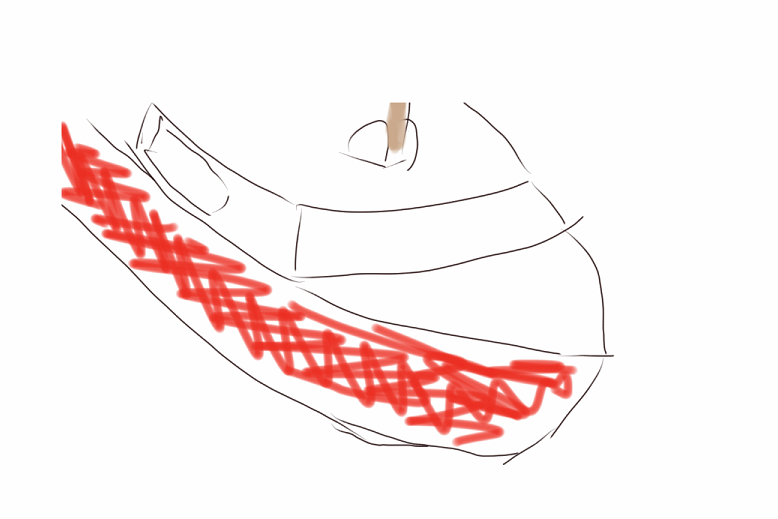 *my £400 shares bought in 1996 made a shed load of money, enough to buy a 32ft HBBR flagship..six of us having a jolly around the Mediterranean? Turn left out of Chichester Harbour, over to France, down the French canals, sample the wine, cheese and lager, turn left in the Med. You know you want to do it, yes??? "We" seem to have a great design here. Chris P, can I persuade (bribe?) you to fit a temporary mounting block for my near-silent electric outboard? The point once again is to prove you don't need a noisy, smelly combustion engine on the Thames. Some jolly tests on speed/distance will show promise, I reckon the 18ft x 3ft space will glide along nicely. The ends are even big enough for solar panels. -Paul |
|
|
In reply to this post by Chris Waite
Yes please to curves!
But first, naming of parts. Punts have a wonderful terminology. The wedges at the ends are called swims, a term borrowed from barges. The ends are huffs. The deck is a till (or box if you are in Oxford, or deck if you are in Cambridge, but not to be confused with a counter, which is the covered end of a racing punt). The bit in the middle is called, rather swankily, the saloon. I envisage a rectangular bottom panel for the saloon, with slightly tapered swims. A bit of flare, but perhaps little or no sheer, thus: 
|
|
|
In reply to this post by Paul H (admin)
>>>>Chris P, can I persuade (bribe?) you to fit a temporary mounting block for my near-silent electric outboard? The point once again is to prove you don't need a noisy, smelly combustion engine on the Thames.
What a shocking suggestion. No, nyet, non, nein, norranchancinell, nada. This vessel will be propelled with pole and paddle as God intends. In addition to which, an engine mount would spoil the lovely curves that C-Dubz is going to draw. So if you want to electrocute yourself, you will have to build your own punt. If you do, I will make you a bespoke punt pole so you can learn this wonderful skill. |
|
|
Though I entirely approve of preventing noisy and smelly boats on the Thames, natch.
BTW, ChrisW, I want to have some storage in the swims as a secure place to put valuables eg wine, beer, gin etc. |
|
|
Chris(P), in your lovely drawing, in the saloon area, am I reading the drawing properly?
Is the straight horizontal line the edge of the floor, and the other outside line the curved outer sheer line, thus showing the sides of the hull are not vertical, but lean outwards? I had presumed the sides would be vertical in a punt, so was confused but it looks like a more shapely version is planned? For those of us who know nothing of punting, if that is the correct terminology, does the pole always reach the bottom or something else? Does it get stuck in the mud? Will the poles be two piece alloy tubing joined or long pieces of wood? Great project. Brian |
|
|
Yes, Brian, most punts have a bit of flare to provide better stability and a more elegant curve to the gunwale. I drew a rectangular base because that is what Michalak did and it must make things simpler as well as maximising the living space.
|
|
|
In reply to this post by BrianP
Oh, and the pole will be a single piece of wood. Aluminium feels horrible in the hand and I suspect will be heavier than wood. Also naffer.
Traditionally, the end of the pole has a metal shoe that is designed to keep it vertical in the water and prevent it sticking in the mud. I am rather tempted by those long high-tech carbon fibre paddles that paddleboarders use, which look as though they would be excellent for close quarter manoeuvring, though I suspect one of those would cost more than the entire punt... |
|
|
In reply to this post by Paul H (admin)
Paul....I suddenly realised we have a modular boat here. Your electric version could look like this....

|
|
|
That's a Eureka moment, something we could easily demonstrate at Beale. She would be dragging a wide transom though, most likely submerged which adds a lot of drag as you know. Ideally a custom till built for electric could be bolted on - the box would be modified to support the electric outboard. Strictly Oxford naming for me, as Liza has an offer to read Maths at Oxford! The custom till would add 4ft back onto the waterline length and shaped so that a narrow transom was just touching the water. Chesapeake Marine Design have a good article on efficient hulls: http://www.cmdboats.com/pdfs/Electric_Boat_Hull_Design_E-Book.pdf Their graph claims the extra 4ft can add half a knot - every little bit counts! 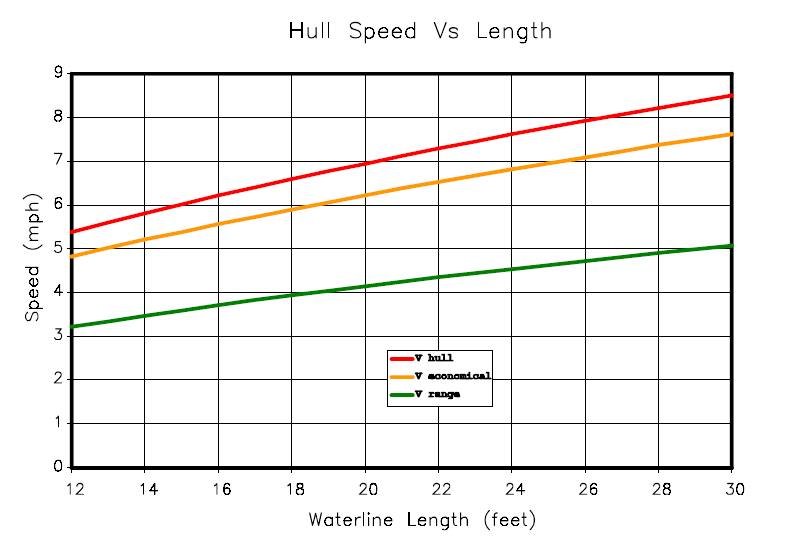 They also claim that 80% of theoretical hull speed is the sweet spot for electric, probably for punting also. As Russia and the USA can both dock with the International Space Station, you would think we could build two tills with holes in the same location.  -Paul |
|
|
If it were me going for an electric punt, that could be made reversible to go in either direction equally well, then I think I'd go for the three section modular design, with identical ends. I'd fit an electric motor in a hole in one end (much as I did with Duck Punt for the CCC) and have it so it could turn right through 360 deg if need be. If the ends, or at least the end with the motor, was hinged to the centre section then it could be lifted in order to bring the prop out of the water.
In fact, thinking this idea through further, why not make both ends hinge at the upper surface edge where they meet the centre section? Not only could they simply flip over to make the punt much smaller when transporting it, but with the addition of two poles and a tarpaulin the ends could be lifted to 90 deg to form the ends of a sleeping tent, with lots of headroom. The sketch below shows the different modes such a creation could adopt: 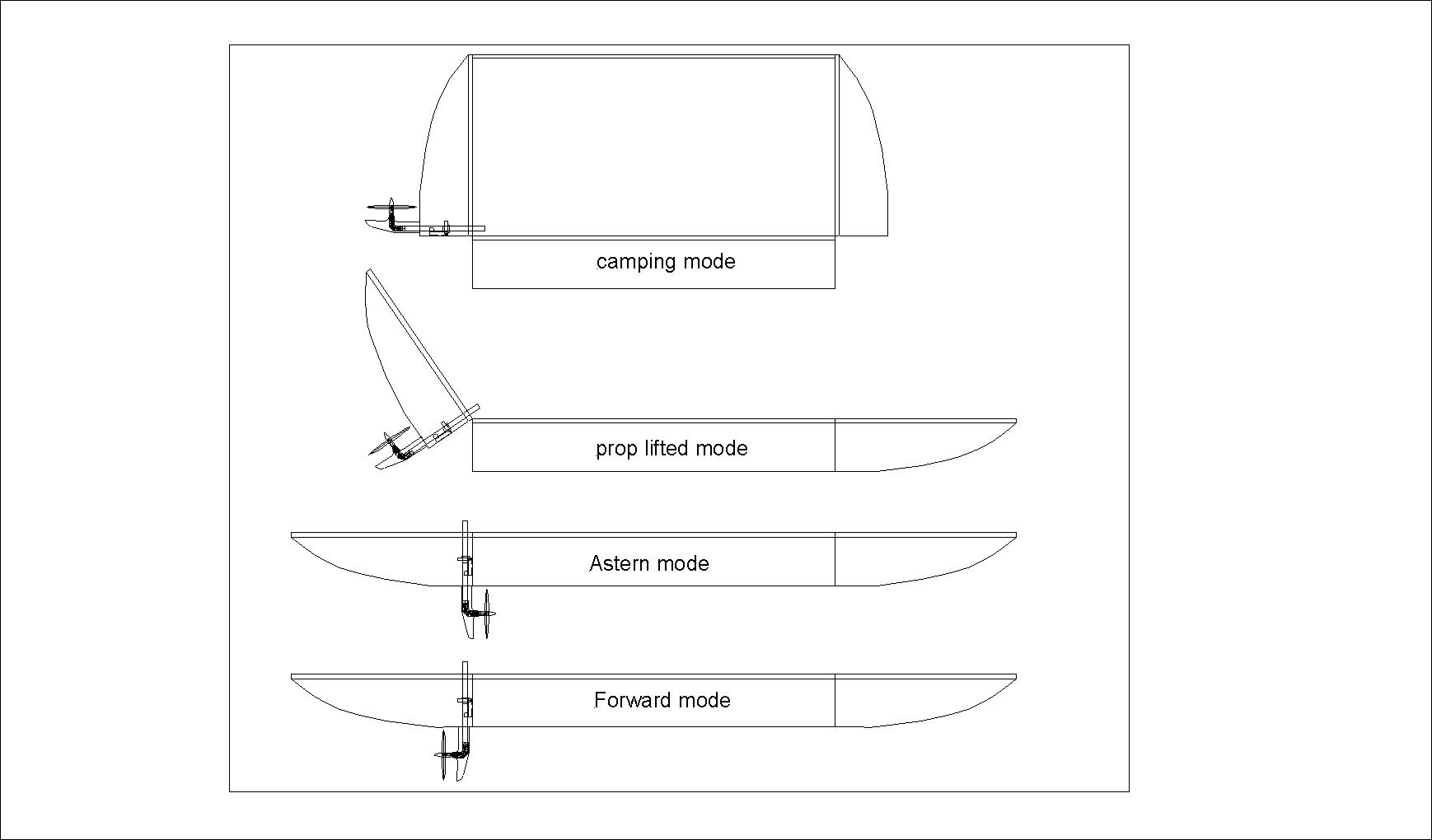
|
|
|
Fascinating thinking. Couple of key engineering issues would need a solution:
first is how to fasten the ends in the down position, the stern in particular will need holding firm to stop it flipping up in reverse, whie still being able to release them easily when required. secondly: if the bow and stern are to flip up at night (nice idea) they will need to be very light to ensure the craft doesn't end up top heavy and unstable. The nightmare of capsizing while wrapped in a sleeping bag still hovers in the back of my mind. Also either means they cannot be used for storage or means they will have to be emptied every night and, in the case of the stern, every time you wan to lift it. They could be a great place to store heavier gear (batteries, food, etc.) out of the way. though, so a simple cheap festival tent might be the simplest accomodation solution. Electric motor for those not valuing the exercise of self propulsion certainly makes sense. The decked bits (sorry, not using proper terminology) would provide space for solar panels, could even have a bimini style roof for more panels (seen it done on a skiff that did the length of the Thames but can't find a pic at the moment, bet Brian will track one down!) On 5 Mar 2014, at 18:49, Jeremy [via UK HBBR Forum] <[hidden email]> wrote: > If it were me going for an electric punt, that could be made reversible to go in either direction equally well, then I think I'd go for the three section modular design, with identical ends. I'd fit an electric motor in a hole in one end (much as I did with Duck Punt for the CCC) and have it so it could turn right through 360 deg in need be. If the ends, or at least the end with the motor, was hinged to the centre section then it could be lifted in order to bring the prop out of the water. > > In fact, thinking this idea through further, why not make both ends hinge at the upper surface edge where they meet the centre section? Not only could they simply flip over to make the punt much smaller when transporting it, but with the addition of two poles and a tarpaulin the ends could be lifted to 90 deg to form the ends of a sleeping tent, with lots of headroom. The sketch below shows the different modes such a creation could adopt: |
|
|
In reply to this post by Jeremy
Jeremy,
Making the ends fold through 180 degrees for towing is a great design idea. It reminds me of the trailer tent we had as a kid in the 70s. Several sheets worth of 9mm and 12mm ply will I think make her too heavy to car top. But the folded 10x3 footprint fits on the smallest of trailers. Bolt on wheels come to mind for manoeuvring on/off the trailer and easy storage in a garage. Designing by committee really is fun  Paul |
|
|
This looks like a fascinating project chaps ! Just to help the discussion along have you seen this punt / camping design. Beautiful it is not, but it does have some well worked out ideas. I came across it the other day at our local boat show in the darkest reaches of the Antipodes.
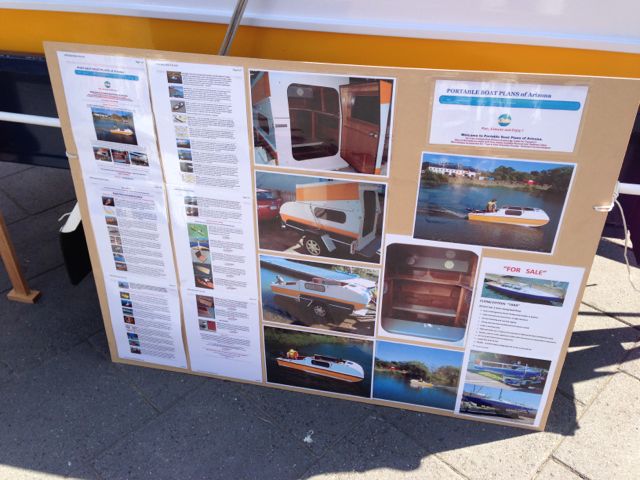 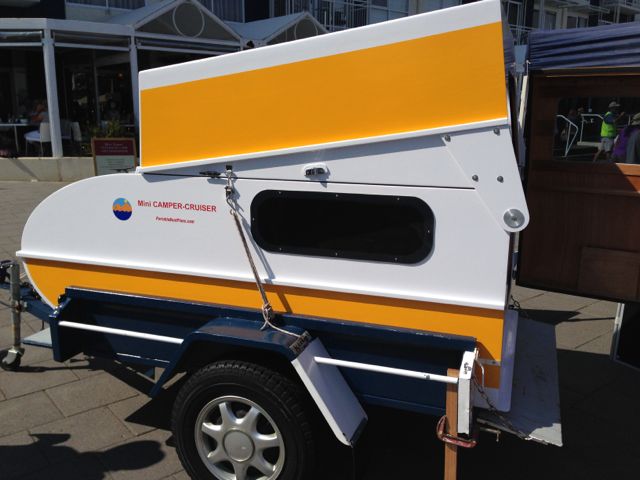 Hope this helps, happy brain storming - John |
|
|
Here is a link to Portable Boat Plans who designed the boat above - not the actual boat but a simple way to bolt two halves without tools:
http://www.portableboatplans.com/resources/KNOB.pdf 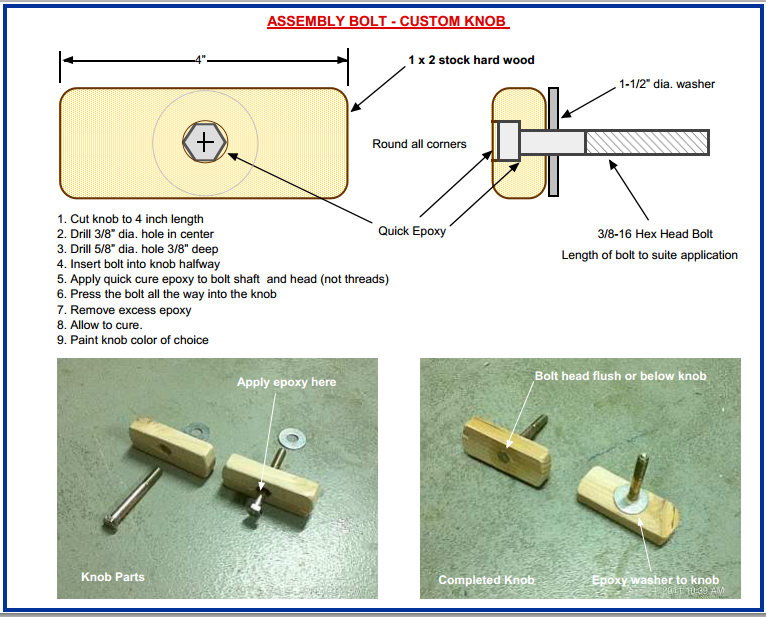 With a large enough block of wood the assembly would float. I would start with an M8 bolt and see how well it worked - spreading the point load over a large area of wood is probably more important than the bolt size. -Paul |
|
|
The centre section when sitting on a lightweight trailer will make a smashing winter and spring gardening box trailer for getting all those bags of rubbish to the local tip!
Ed mentioned that he recalls that the 10 x 5 birch ply sheets from Mayer can be bought with the main plies either lengthwise or crosswise, if you get what I mean. Brian |
|
|
In reply to this post by Chris Waite
I question the need for all that additional weight, when Jim's original punt was built from 6mm ply and weighs 110 pounds empty. There were ample external chine logs, stiffeners, gunwales and frames to make her strong enough to be dragged over a weir. 9mm ply for the bits you stand on makes sense, but everything else could be 6mm - discreet curvature would significantly strengthen the 6mm and add kerb appeal. It might be cheaper to laminate 2x6mm to make the main bulkheads or laminate 2x1 vertically over the bolt holes. Here's how some people do it. The wooden bolt I described could neatly align with the 2x1: 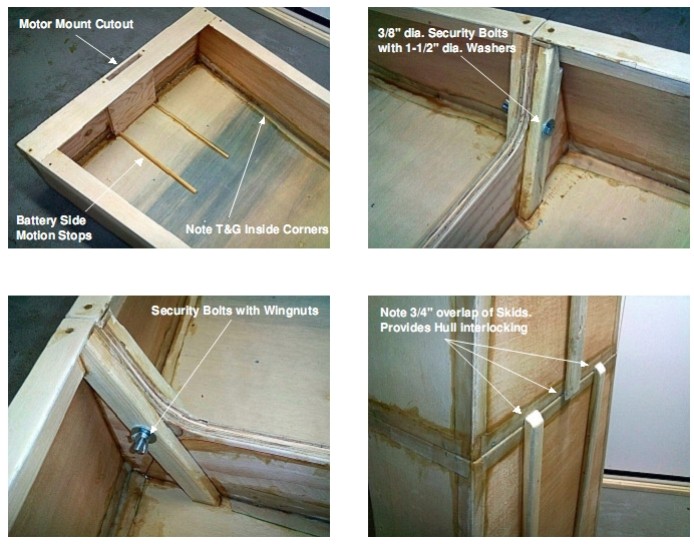 (from http://www.portableboatplans.com/poke-about.php) Having said that MilliBee's curved roof laminated from 2 x 4mm is extremely strong. A slight curve in the box deck, like a foredeck, might just work and it would soften the lines. Any spare ply can be passed on to build a second punt, I'm sure many of us would be interested (although I would have to kill Tigger, obeying the 2 boats in the garden rule  ) )
-Paul |
|
|
So the game it on, is it?
Now, young Paulie.... First of all Michalak's punt is nearly three foot shorter, nine inches less on the beam, and the decks about 2 foot 6 inches long, not 4 feet and it's not in three separate sections requiring bolt-together bulkheads, or being party to an open 10 foot by three foot by one foot tray as a centre section. That together with with the motive parts hung almost in thin air on each end, being used to stand on in real punting fashion: 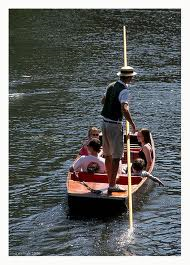 Neither do they have to withstand our Christopher's substantial frame arriving from the height of a lock. And finally, by the time you have installed all those extra straps to support your meagre laminations, you might as well have used something worthwhile in the first place; Chris is reckoning to stitch and tape his seams and I considered merely the one central keel-runner under the main tray, with nothing more than out(gun)wales and one frame midships, incorporating a removable thwart. Apart from that I agree with you entirely. Actually that's not quite all I have suggested three different thicknesses. The 5 x 10 foot piece, sufficient for sides, bottoms and bulkheads of the swims (ends) is already the 6mm you're so keen on; the reason being that they form all but the decks of a monocoque construction. The other 5 x 10 foot piece is 9mm and would make the bottom and sides of the central tray section where life will be stomping back and forth as it has a habit of doing, but without putting a foot through the floor. The last 12mm piece is only 4 foot x 8 foot and that is to make decks that even Mr Partridge would be happy to river-dance on, though I would be prepared to reduce this to 9mm as well, with adequate underlying support. There will be sufficient spare in this last piece to make up the end bulkheads of the central tray as they will have the swims hanging off them and for the want of an extra 0.07 of a cubic foot of ply, it would prove easier to use this up than buy another sheet. And this is what it would look like: 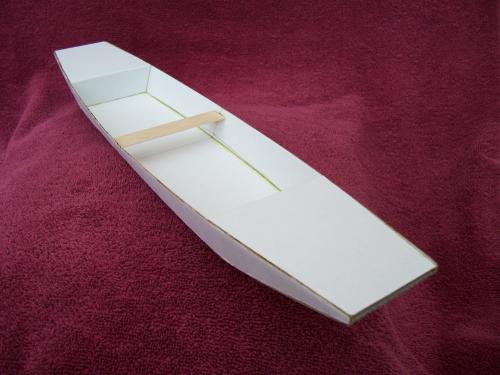 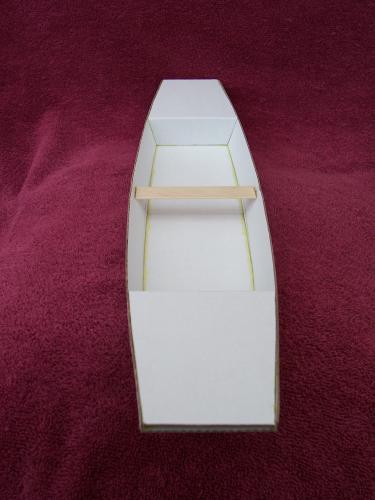 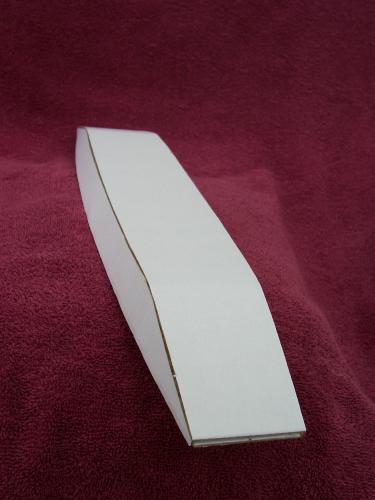 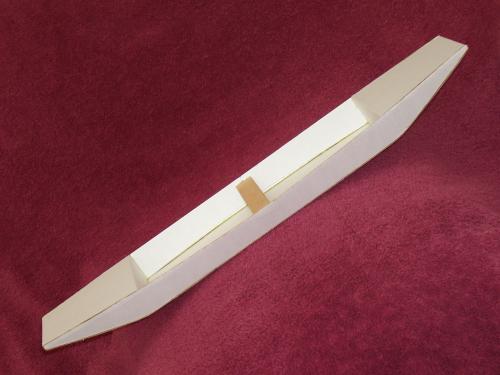 17 feet, nine inches LOA, by 3 foot 9 inches beam inside the gunwale which is flared out from 3 foot dead across the bottom. For comparison at the same scale, I have slipped 'Curvy Mabel' alongside: 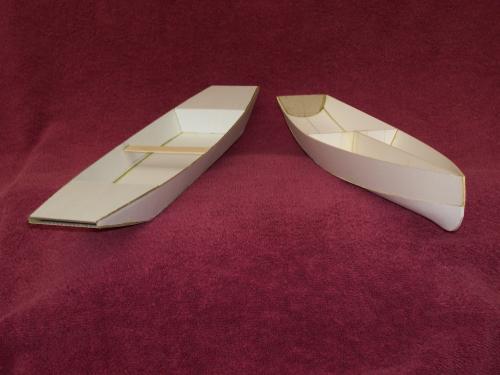 Note, as you have suggested, that there are some curves introduced - mainly into the sides, carried from the central section right up through the 'swims' to each end. The bottom of the main 'tray' is absolutely flat, but the bottom of the 'swims' curve round, but not too fiercely, to avoid any sharp angle between them and the main floor. There is not much room for manoeuvre at this point, as you want waterline length while retaining a shallow angle of attack to ease flow under the hull. The actual end strips would be of sufficiently sturdy timber, perhaps one or two inches deep to allow for ramming anything in your way - light vessels and docksides, etc. In the model, they have been left as open slits. It occurred to me that anyone needing a hide for pet goblins to go duck hunting or similar, might find this a useful additional feature. Whaddaya think of it so far? Puntius Pilot |
|
|
Seeing a model brings it to life. Looks good. The curve relieve's the otherwise potentially 'boxy' look without introducing serious building complications.
A traditional way to punt, rather than standing on the stern, is to walk forward in the body of the punt, plant your quant/pole/thing start your push and then walk back to the stern while still pushing. Worth bearing that option in mind when debating floor thicknesses. I'd put in a vote for floor boards. It's very difficult mopping a boat completely dry after rain. Floor boards just lift you that inch so water in the bilges stays out of your sleeping bag. Understand the weight penalty but you spend more time sleeping in the boat than carrying it. Also means that if you do step heavily and crack anything it won't be the hull! I now have a clear picture of Chez Waite: a house lined in plush red velvet and display shelves filled with models of boats. Tim. |
«
Return to General Discussion
|
1 view|%1 views
| Free forum by Nabble | Edit this page |


